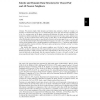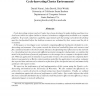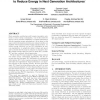663 search results - page 27 / 133 » On the Foundations of Expected Expected Utility |
106
Voted
TALG
2008
14 years 9 months ago
2008
We present simple, fully dynamic and kinetic data structures, which are variants of a dynamic two-dimensional range tree, for maintaining the closest pair and all nearest neighbors...
JSAC
2008
14 years 9 months ago
2008
We study in this paper a noncooperative approach for sharing resources of a common pool among users, wherein each user strives to maximize its own utility. The optimality notion is...
104
Voted
SIGSOFT
2006
ACM
15 years 10 months ago
2006
ACM
Recent software systems usually feature an automated failure reporting system, with which a huge number of failing traces are collected every day. In order to prioritize fault dia...
72
Voted
CLUSTER
2005
IEEE
15 years 3 months ago
2005
IEEE
Cycle-harvesting systems such as Condor have been developed to make desktop machines in a local area (which are often similar to clusters in hardware configuration) available as ...
CF
2004
ACM
15 years 2 months ago
2004
ACM
Next generation architectures will require innovative solutions to reduce energy consumption. One of the trends we expect is more extensive utilization of compiler information dir...



